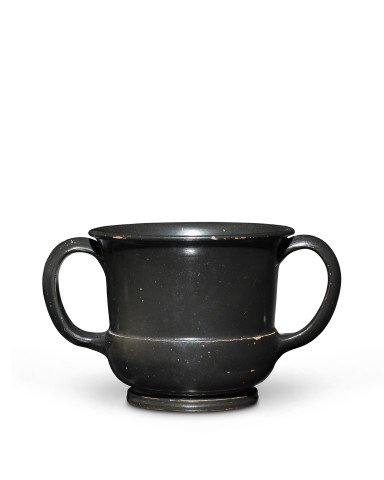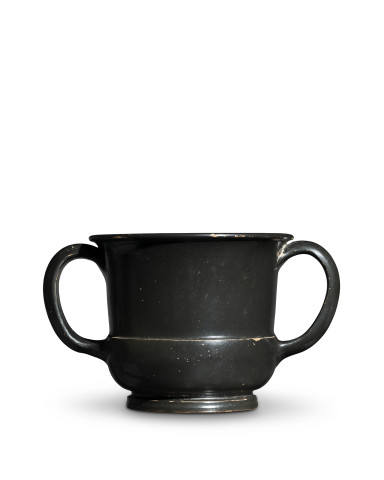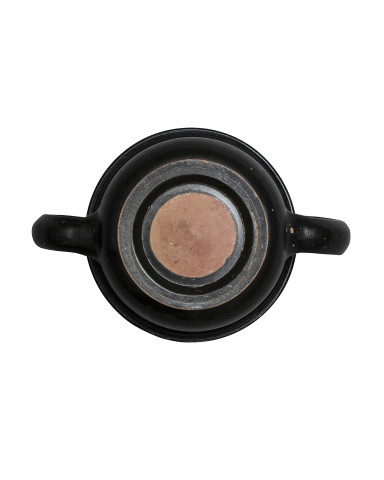162. Greek black-glaze sessile kantharos, Athens, c.450-425 BC
Terracotta
Height: 8cm, diameter: 9.2cm, width across the handles: 13.6cm
9917
Further images
The twin-handled cup has a tall, slightly flaring wall and a shallow rounded bowl, with elongated loop handles joined from the carination to just beneath the out-turned lip. The low...
The twin-handled cup has a tall, slightly flaring wall and a shallow rounded bowl, with elongated loop handles joined from the carination to just beneath the out-turned lip. The low foot has an elaborate moulding, the glaze continuing over the resting surface and inner wall and beginning to enclose the cushioned underside, which is reserved and with a red wash.
Intact, some scattered losses to the glaze.
The kantharos (pl. kantharoi) is a cup used specifically for drinking wine and is commonly depicted on figured vases in Bacchic scenes where the god of wine, often in a state of inebriation, is holding such a cup. The kantharos is characterised by its deep bowl and two vertical handles. The sessile kantharos is a subdivision of this shape, whose stability made it a popular form. The development of these vessels is so limited that it is assumed they all originate from one workshop, near to the Agora in Athens. The term ‘sessile’ applies specifically to kantharoi with their distinctive shape of handle, which can vary in length down the body but never rises above the rim.
Intact, some scattered losses to the glaze.
The kantharos (pl. kantharoi) is a cup used specifically for drinking wine and is commonly depicted on figured vases in Bacchic scenes where the god of wine, often in a state of inebriation, is holding such a cup. The kantharos is characterised by its deep bowl and two vertical handles. The sessile kantharos is a subdivision of this shape, whose stability made it a popular form. The development of these vessels is so limited that it is assumed they all originate from one workshop, near to the Agora in Athens. The term ‘sessile’ applies specifically to kantharoi with their distinctive shape of handle, which can vary in length down the body but never rises above the rim.
Provenance
Private collection, Ticino, Switzerland; acquired prior to 1970Literature
Compare Brian A. Sparkes and Lucy Talcott, The Athenian Agora, Vol.XII, Black and Plain Pottery (Princeton, 1970), pl.27, no.633.For a disussion on the development of the kantharos, with particular reference to the sessile form, read E. Mulder, Boeotia, Land of the Kantharos: Explanations for the high number of kantharoi present in the Archaic and Classical period in Boeotia (Leiden, 2012), pp.10-11
2
of 2





